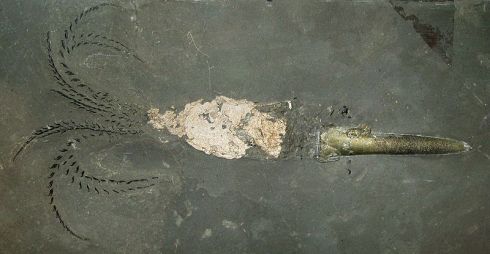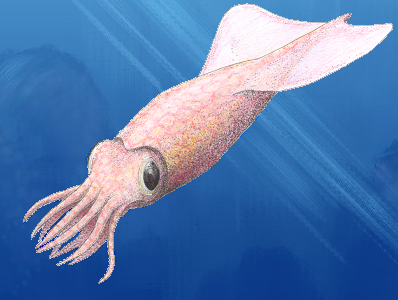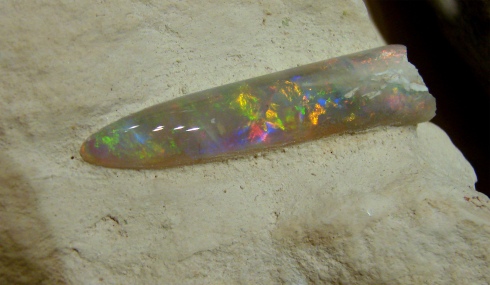You are currently browsing the tag archive for the ‘Mesozoic’ tag.
Here is a Cretaceous drama (including both original players) captured in amber and perfectly preserved for 99 million years. A predatory “hell ant” (haidomyrmecine) was grasping a proto-cockroach (Caputoraptor elegans) in its strange vertical mandibles when a dollop of sap preserved both creatures in resin. Because it was so well preserved, we can see how the hell ant’s mouth parts are completely different from those of modern ants. Today’s ants all have horizontal side to side scissor-like mandibles. The ancient hell ant has scythelike vertical mandibles which meet up with horn like appendages on its forehead (like a platybelodon…if its upper tusks came out above its eyes).

The ant was found in a piece of amber from modern Myanmar and gives us a precious window into the lives of ancient ants (which were seemingly as widespread in the age of the dinosaurs as they are now, yet were also completely different than they are now). The first ants evolved during the Jurassic (170 million years ago) so the hell ant is nearly as far removed from its first ancestors as today’s ants are from it. Sometimes it seems like the way we picture the world–an empire belonging to dinosaurs, Andrewsarchus, or humans–must be ridiculous to ants. To them we macrofauna must seem like ludicrous obscene monsters who dwell in a different world and are doomed to disappear in the immediate future (the same as Kardassians appear to us normal people).
During the Mesozoic, the age of dinosaurs, mammals were widespread, but they kept a low profile so as to avoid the baleful attention of the great reptiles. A fossil of one of these furtive early mammals was discovered last November (2011) in Argentina. The creature was christened as Cronopio dentiacutus, and not only does the animal’s partial skull give us a window into mammalian form in the late Cretaceous it also provides a special treat for regular readers of Ferrebeekeeper, for like the Smilodon, the walrus, and the Odobenocetops, Cronopio has distinctly pronounced saber teeth (despite being a small scurrying squirrel-like creature).
Cronopio dentiacutus was probably actually more shrew-like than squirrel-like and used its saber teeth for hunting insects. Based on its large eye sockets, Cronopio most likely hunted its prey at night (when it could also more easily escape the attention of the dinosaurs and other larger predators.
Cronopio dentiacutus takes its species name from a Greek phrase meaning sharp teeth, but the origin of its genus name is rather more literary. The Argentine surrealist writer Julio Cortázar wrote several books about abstracted categories of fictional entities and the Cronopio was the idealistic but disorganized type of being (as opposed to rigid, highly-organized “famas” and indolent, dull “esperanzas”). It is unclear what creative/idealistic features of this insectivorous early mammal struck the fancy of the discovering paleontologist to provoke such a name, but it is nice to see scientists pay Argentine belles-lettres such an acknowledgement.
A few weeks ago Ferrebeekeeper featured a post about belemnites, extinct cephalopods from the Mesozoic which teemed in immense schools through the reptile-haunted oceans of that bygone era. Yet belemnites were certainly not the only cephalopods which swam in the Mesozoic seas. Numerous shelled cephalopods—the ammonites—were widespread in every sort of marine habitat. Ammonites are personal favorites of mine so I am not going to write a comprehensive explanation/description of the subclass. Instead I wish to provide you with an idea of how big ammonites could get by providing a few pictures of large ammonite fossils which have been discovered. Imagine these monsters jetting through the water with huge tentacles and big intelligent eyes scanning for giant predatory reptiles and you will have a better idea of the Mesozoic Oceans!
This blog has already traveled back 400+ million years to the Ordovician, the era when great mollusks ruled earth’s oceans. The Ordovician ended in ice as Gondwanaland drifted into the Southern Polar regions—a tectonic shift which brought massive terminal cooling to the great reef systems of the time (and also fundamentally changed Earth’s climate and atmosphere), but the cephalopods were hardly done for. They continued to evolve and adapt to the world’s ever changing oceans. Today we pick up the cephalopod story hundreds of millions of years later during the Mesozoic era—the time of dinosaurs.
The reefs and oceans of the Jurassic and Cretaceous were filled with nautiloid cephalopods—ram shelled descendants of the shelled tentacled monstrosities from the Ordovician—but a new cephalopod had also evolved and filled up the shallow limestone seas in giant teaming schools. These were the belemnites which lacked an external shell and superficially resembled squid.
Belemnites were distinct from today’s squids for several reasons. Not only did they possess hard internal shells/skeletons composed of calcium carbonate but they also lacked the pair of specialized hunting tentacles present in modern cuttlefish and squid. Instead the belemnites hunted with ten arms covered in tiny wicked hooks.

An Amzaingly well preserved fossil belemnite from the 155 million year old Jurassic Solnhofen limestones in Germany (notice the details of the animal's soft anatomy)
Belemnites fed on ostracods, crustaceans, and fish. In turn they made up a sizeable portion of diet for, well, the sizeable predators of the time. Fossils of plesiosaurs, pliosaurs, and giant sharks have been discovered with stomachs full of hooks or rostra. It is also thought that the dolphin-like ichthyosaurs survived largely on belemnites. After feeding and digesting the mollusks, the ichthyosaurs probably vomited out the indigestible hooks and rostra of belemnites much in the manner that sperm whales expel the hooks of giant squid!
The bullet shaped rostra of belemnites have survived in vast numbers and are one of the most characteristic of all Mesozoic fossils. These strange tapered cones weathered out of soft chalks nearly intact and proved extremely puzzling to people of past generations. Numerous magical common names and magical folk beliefs grew out of the conical rocks. The English called the fossils “thunderbolts” and believed they were the physical leftovers from lightning strikes. The ancient Scandinavians thought that belemnite rostra were candles dropped by gnomes, elves, and dwarves on the occasions they traveled from their realms through this world. The ancient Chinese called them “sword stones” and believed they were imbued with ancient healing magic.
The end of belemnites was even more astonishing than these myths. The creatures had short lives—which involved a larval phase drifting amidst the microscopic plankton. The immense extraterrestrial bolide which struck the Earth at the end of the Cretaceous ended the dinosaurs and also finished off the belemnites. The little larvae were unable to survive the massive planktonic die-off which accompanied the long dark winter following the strike. Fortunately other cephalopods proved hardier–and the most intelligent mollusks continued to change and adapt right up until today.
It is the holiday season and decorated conifers are everywhere. Seeing all of the dressed-up firs and spruces reminds me that Ferrebeekeeper’s tree category has so far betrayed a distinct bias towards angiosperms (flowering plants). Yet the conifers vastly outdate all flowering trees by a vast span of time. The first conifers we have found date to the late Carboniferous period (about 300 million years ago) whereas the first fossils of angiosperms appear in the Cretaceous (about 125 million years ago) although the flowering plants probably originated earlier in the Mesozoic.
The first known conifer trees resembled modern Araucaria trees. They evolved from a (now long-extinct) ancestral gymnosperm tree which could only live in warm swampy conditions—a watery habitat necessitated since these progenitor trees did not cope well with dry conditions and also probably utilized motile sperm. Instead of relying on free-swimming gametes and huge seeds, the newly evolved conifers used wind to carry clouds of pollen through the air and were capable of producing many tiny seeds which could survive drying out. Because the evergreen cone-bearing trees could survive in drier conditions, the early conifers had immense competitive advantages. These advantages were critical to survival as the great warm swamps of the Carboniferous dried out. The continents, which had been separated by shallow oceans and seas, annealed together into the baking dry supercontinent of Permian Pangaea. In the arid deserts and mountains, the conifers were among the only plants which could survive.
This ability to live through any condition helped the conifers get through the greatest mass extinction in life’s history—The Permian–Triassic (P–Tr) extinction event, (known to paleontologists as “the Great Dying”). Thereafter, throughout the Mesozoic they were the dominant land plants (along with cycads and ginkgos which had evolved at about the same time). The Mesozoic saw the greatest diversity of conifers ever—the age of dinosaurs could just as well be called the age of conifers. Huge heard of sauropods grazed on vast swaths of exotic conifers. Beneath these strange sprawling forests, the carnosaurs hunted, the early birds glided through endless green canyons, and the desperate little mammals darted out to grab and hoard the pine nuts of the time.
Although flowering plants rapidly came to prominence towards the end of the Cretaceous and have since become the most diverse plants, today’s conifers are not in any way anachronisms or primitive also-rans. They still out-compete the flowering trees in cold areas and in dry areas. Conifers entirely dominate the boreal forests of Asia, Europe, and North America—arguably the largest continuous ecosystem on the planet except for the pelagic ocean. They form entire strange ecosystems in the Araucaria moist forests of South America—which are relics of the great conifer forests of Antarctica (the southern continent was once a warmer happier place before tectonics and climate shift gradually dragged its inhabitants to frozen death).
The largest trees—the sequoias and redwoods–are conifers. The oldest trees—bristlecone pine trees and clonal Spruces–are conifers (excepting of course the clonal colonies). Conifers are probably the most commercially important trees since they are fast-growing staples of the pulp and the timber industries. Timber companies sometimes buy up hardwood forests, clear cut the valuable native deciduous trees and plant fast growing pines in their place to harvest for pulp. In fact all of the Christmas trees which are everywhere around New York come from a similar farming process. The conifers are nearly everywhere—they have one of the greatest success stories in the history of life. It is no wonder they are the symbol of life surviving through the winter to come back stronger. They have done that time and time again through the darkest and driest winters of the eons.
When we think of living reefs we are likely to think of coral reefs, since the biotic reefs of today are most often composed of cnidarian corals (and coralline algae). Such has not always been the case –convergent evolution means that other animals have sometimes jumped in and taken over the central reef building role occupied today by corals (indeed there are still oyster reefs in some parts of the ocean although human hunger for oysters has greatly reduced their size). One of the more interesting and successful of these coral analogs was actually a modified colonial mollusk—the rudist. Rudists were bivalve mollusks very similar to the clams you enjoy on your linguini. Like clams, rudists had two shells (or valves) joined at a hinge. However the rudists possessed very different shapes from modern clams. Some had horn-shaped shells which lay flat on the bottom of the ocean shore (the horns prevented currents from flipping the mollusks or washing them away). The other major group had cone-shapes with little hinged lids on top –like a cross between a lidded beer stein and an ice-cream cone). This latter group formed together in huge super colonies.
Rudists evolved in the Jurassic Era and burgeoned throughout the Mesozoic, but their greatest success came during the Cretaceous when they pushed out corals and sponges to become the major reef-building organisms in the Tethys Ocean and various other warm tropical shelves around the world. It is believed that rudists were so successful because the ocean’s temperature was so much higher during the Cretaceous (as was the salt content of the water). It must have been amazing to see a rudist tropical reef thronged with strange colorful belemnites, ammonites, and unknown teleosts. Huge prehistoric diving birds, mosasaurs, and super sharks would have lurked in the depths beside the reef.
Like the dinosaurs and the ammonites, the rudists were wiped out by the Chicxulub impact. Sometimes I think about the rudists as I fret about coral die-offs. Coral quickly evolved back into the warm shallow tropical niche left open by the extinction of the rudists. Is there some little clam with a big destiny waiting for the corals to falter in the ever-warmer, ever-more-acidic oceans of the present?
Ferrebeekeeper has an abiding interest in monotremes including both the poisonous platypus and the enigmatic echidnas (with their advanced frontal cortex). But sadly that is about it as far as it goes for the extant egg-laying mammals: there are only two living families of monotremes (with a scanty total of five species split between them). To learn more about these animals one must turn to paleontology. Unfortunately even in the fossil record, monotremes are extremely rare.
Based on genetic evidence, biologists believe that the first monotremes made their advent in the history of life about 220 million years ago during the Triassic era; however the earliest known fossil monotreme so far discovered was a fossil jaw from the early Cretacious era about 120 million years ago. The bones belonged to Steropodon galmani, which seems to have been a beaked swimmer about 50 cm (20 inches) long which lived in Australia. Steropodon was apparently a giant among Cretacious mammals–most of which seem to have been shrew-sized (so as to better avoid attention from their contemporaries, the dinosaurs). Reconstructions of Steropodon all seem to resemble the platypus, and most paleantologists would probably concede that it was a sort of platypus—as apparently were other Mesozoic fossil monotremes such as Kollikodon and Teinolophos (platypuses and these platypus-like forbears are called the Ornithorhynchida). During the Cretaceous era, the land which is now Australia was in the South Polar regions of the world (approximately where Antarctica is today). Although temperatures were much warmer during the Cretaceous, monotremes must still have been able to deal with terrible cold: it is believed that the extremely efficient temperature control and the deep hibernation mechanism which these animals continue to display first evolved during that time.
The only monotreme fossil which was not found in Australia was from another platypus-like creature named Monotrematus sudamericanum. The creature’s remains were found in a Patagonian rock formation from the Paleocene era (the era just after the fall of the dinosaurs). Monotremes probably flourished across South America and Antarctica, as well as on Australia, but evidence is still scarce. There are most likely many interesting monotreme fossils throughout Antarctica, but, for some reason, paleontologists have not yet discovered them. Additionally, unlike the marsupials (which still quietly flourish throughout South America), the poor monotremes were wiped out on that continent.
Last week I wrote about the Eocene era and the great proliferation of mammalian types which took place during that warm and fecund time. Although most families of mammals alive today first appeared on the scene during the Eocene, obviously the monotremes were already incredibly ancient. The Eocene does however seem to have been significant time for the monotreme order: the aquatic platypuses were apparently the ancestral monotremes, and echidnas (the Tachyglossidae) probably split off from them during the Eocene. Unfortunately we have no Eocene monotreme fossils so this conclusion is based on genetic evidence and on the suffusion of Miocene monotremes which include representatives of both Ornithorhynchida and Tachyglossidae. Some of these latter creatures are spectacular, like Zaglossus hacketti the giant echidna from the Pleistocene which was about the size of a ram! As Australia dried up so did the monotremes and now there is only one species of platypus left…
Well, that’s a cursory history of the monotremes based on what we know. I wish I could tell you more but unfortunately there is no fossil evidence concerning the first half of the order. Sometimes I like to imagine the first monotremes—which were probably clunky, furry platypus-looking characters with an extra hint of iguana thrown in. These creatures fished in the alien rivers of the Triassic world in a time when dinosaurs and pterosaurs were also still evolving.



























